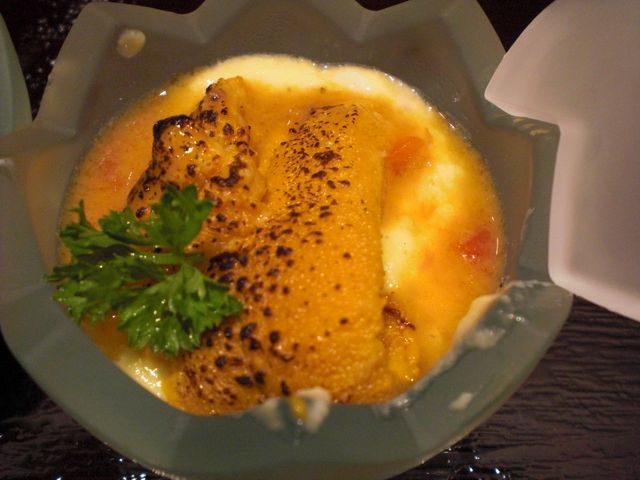Chawan-mushi 茶碗蒸し meaning "steamed in a tea bowl" is a quintessential Japanese dish and a perfect first dish to serve. It is subtle in flavor and delicate in texture. Many Westerners may feel that this dish is rather bland and boring. As a result, only a few Japanese restaurants serve this dish in the U.S. One of our old friends who is originally from Japan but has been living in the U.S. for the past 50 some years adores this dish and I make it almost every time she comes to dinner at our home. We ordered sashimi items from
Catalina Offshore Products for a dinner we had recently with my friend and her husband. We served an Izakaya style course dinner for them. The dishes were: 1. Chawan-mushi 茶碗蒸し、2. Fatty tuna sashimi 大トロの刺身, 3.
Scallop sashimi three ways ホタテの刺身三種類, 4.
Potato gratin square and green asparagus sauteed in butter ジャガイモとサツマイモのグラタン、アスパラ添え, 5.
Pork gyoza 餃子, 6. Rice,
buta-jiru misosoup, and
asazuke ご飯、豚汁、キュウリの浅漬. As a desert, my wife made small individual Pennsylvania dutch (
Deutsch) chocolate cakes. Besides Chawan-mushi, I may be able to post some of these dishes in the near future.
When making chawan-mushi, the ratio of eggs to broth is very important. Too much eggs, it will come out too hard, too much broth it will not set. This is one of the rare occasions when I measure ingredients carefully. For the six small servings I measured three large eggs in a measuring cup (about 150ml if you use "large" eggs) and the final seasoned broth should be three times the amount of the eggs, i.e. 450ml in this example. I usually make Japanese
dashi broth from kelp and dried Bonito flakes but a good quality commercial chiken broth also works (although the final product will be slightly different in flavor). I even made this dish using a commercial vegetable broth for our vegetarian friends with reasonably good results. I first measure about 400ml of broth and add 1-2 tsp of soy sauce (or light colored soy sauce or
"usukuchi sho-yu" 薄口醤油 if you want the color of the end product to be light yellow), 2-3 tbs of mirin and 1/2 tsp of salt (you may omit the salt if you are using salted commercial broth) and top it off with the broth to make it to exactly 450ml or whatever is three time the volume of the eggs. Mix the eggs into the seasoned broth and set aside.
The garnish or items you could put into Chawa-mushi are quite numerous but my usual items include; thinly sliced bite size Chicken tenders, ginko nuts or
"gin-nan" 銀杏 (you can buy them in a can in a Japanse grocery store) or prepared chestnuts preserved in simple syrup or "kuri no kanroni" 栗の甘露煮 (comes in a jar, also available in a Japanese grocery store), shiitake mushroom and/or
nameko mushroom なめこ (small slimy mushroom, also available in a Japanese grocery store, comes in a can, wash to remove slimy coat), Kyoto-style small flower-shaped wheat gluten called "kyo-hana-bu" 京花麩 (re-hydrated), shrimp, some kind of greens such as snow peas or tips of asparagus, and thinly sliced scallion. If available, I prefer to use a Japanese herb/green called "
mitusba" 三つ葉 instead of scallion. Other common items are prepared
cooked eel 鰻の蒲焼き, tofu, Japanese omelet ("
dashimaki tamago" 出し巻き卵、egg-in-egg works surprisingly well), Japanese noodles etc.
I usually put ginko nuts and/or chestnuts, several small pieces of chicken in the bottom and, then, pour the egg mixture through a fine strainer (this is an important step, if you skip this, there will be white clumps of unpleasant hard pieces in the final products) to 70% of the depth of the bowl. I set up my electric wok for steaming and place the filled bowls in the already steaming wok for 10-15 minutes (the steam should be steady but not too strong to prevent the custard from developing air holes). When the surface is just barely set, I add small whole shitake mushrooms (stem removed with decorative cuts if so desired), asparagus tips or snow peas, and kyo-hana-bu. Steam another 5-7 minutes and add shrimp and chopped scallion (or "mitsuba"). Additional 5-7 minutes will be sufficient to cook the shrimp. The reason for adding the garnish in stages is to distribute them throuhout the custard rather than have everything sink down to the bottom which would happen if you added everything at the begining. It also prevents the greens and the shrimp from overcooking.
Ususally, this is served hot. If you have leftovers (as we usually do), keep in the refrigerator covered and serve cold the next day. It is a nice refreshing dish to eat especially in hot summer days. You could add a small amount of sauce (a cold sauce made of usual soy sauce, mirin and dashi) with a dab of wasabi on the surface of the chawan-mushi, since the taste diminishes when the egg is cold.






